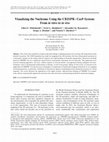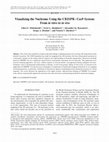Papers by Victoria Zherdeva
Современные проблемы науки и образования, 2013
Современные проблемы науки и образования, 2013
Доклады Белорусского государственного университета информатики и радиоэлектроники, 2018

Biokhimiya, 2023
One of the latest methods in modern molecular biology is labeling genomic loci in living cells us... more One of the latest methods in modern molecular biology is labeling genomic loci in living cells using fluorescently labeled Cas protein. The NIH Foundation has made the mapping of the 4D nucleome (the three-dimensional nucleome on a timescale) a priority in the studies aimed to improve our understanding of chromatin organization. Fluorescent methods based on CRISPR-Cas are a significant step forward in visualization of genomic loci in living cells. This approach can be used for studying epigenetics, cell cycle, cellular response to external stimuli, rearrangements during malignant cell transformation, such as chromosomal translocations or damage, as well as for genome editing. In this review, we focused on the application of CRISPR-Cas fluorescence technologies as components of multimodal imaging methods for in vivo mapping of chromosomal loci, in particular, attribution of fluorescence signal to morphological and anatomical structures in a living organism. The review discusses the approaches to the highly sensitive, high-precision labeling of CRISPR-Cas components, delivery of genetically engineered constructs into cells and tissues, and promising methods for molecular imaging.
Biomedical Engineering, Sep 1, 2019
The development and investigation of biosensors for the early and rapid diagnosis of a wide spect... more The development and investigation of biosensors for the early and rapid diagnosis of a wide spectrum of diseases to provide significant reductions in mortality and loss of working time as a result of timely treatment is a current challenge in many countries. The active progress in biosensor technology is promoted by the fact that it is an interdisciplinary field exploiting advancements in very diverse areas of knowledge: from physiology to nanotech nology and electronics.
Dynamics and Fluctuations in Biomedical Photonics XX
Materials, Jan 19, 2023
Tet-Regulated Expression and Optical Clearing for In Vivo Visualization of Genetically Encoded Ch... more Tet-Regulated Expression and Optical Clearing for In Vivo Visualization of Genetically Encoded Chimeric dCas9/Fluorescent Protein Probes.

Biochemistry (Moscow)
One of the latest methods in modern molecular biology is labeling genomic loci in living cells us... more One of the latest methods in modern molecular biology is labeling genomic loci in living cells using fluorescently labeled Cas protein. The NIH Foundation has made the mapping of the 4D nucleome (the three-dimensional nucleome on a timescale) a priority in the studies aimed to improve our understanding of chromatin organization. Fluorescent methods based on CRISPR-Cas are a significant step forward in visualization of genomic loci in living cells. This approach can be used for studying epigenetics, cell cycle, cellular response to external stimuli, rearrangements during malignant cell transformation, such as chromosomal translocations or damage, as well as for genome editing. In this review, we focused on the application of CRISPR-Cas fluorescence technologies as components of multimodal imaging methods for in vivo mapping of chromosomal loci, in particular, attribution of fluorescence signal to morphological and anatomical structures in a living organism. The review discusses the approaches to the highly sensitive, high-precision labeling of CRISPR-Cas components, delivery of genetically engineered constructs into cells and tissues, and promising methods for molecular imaging.

NMR in Biomedicine
Multimodality registration of optical and magnetic resonance (MR) images in the same tissue volum... more Multimodality registration of optical and magnetic resonance (MR) images in the same tissue volume in vivo may be enabled by MR contrast agents with optical clearing (OC) effect. The goals of this study were to a) investigate the effects of clinical MR contrast agent gadobutrol (GB) and its combinations as potential OC agent assisting in fluorescence intensity (FI) imaging in vivo; b) evaluate MRI as a tool for imaging of topical or systemic application of GB for the purpose of OC. Subcutaneous tumor xenografts expressing red fluorescent marker protein were used as disease models. MR imaging was performed at 1T 1 H MRI using T1w-3D GRE sequences to measure time-dependent MR signal intensity changes by ROI analysis after image segmentation. Topical application of 1.0 M or 0.7 M GB-containing OC mixture with water and dimethyl sulfoxide (DMSO) showed similar 30-40% increase of tumor FI during the initial 15 min. Afterwards, the OC effect of GB on FI and tumor/background FI ratio showed a decrease over time in the case of 1.0 M GB unlike 0.7 M GB mixture, which resulted in the steady increase of FI and tumor/background ratio for 15-60 min. The use of T1w-3D GRE MR pulse sequences showed that concentrated 1.0 M GB resulted in MR signal loss of the skin due to high magnetic susceptibility and that signal loss coincided with OC effect. Intravenous injection of 0.3 mmol GB/kg resulted in rapid but transient 40% increase of FI of the tumors. Overall, 1T MRI enabled tracking GB-containing OC compositions on the skin surface and tumor tissue supporting the observation of time-dependent FI increase in vivo.

Apoptosis is one of the variants of the programmed cell death. The main effector enzyme in the pr... more Apoptosis is one of the variants of the programmed cell death. The main effector enzyme in the process of apoptosis is the caspase-3. Level of caspase-3 activity is a good marker for the detection of apoptosis. Real-time determination of the caspase-3 activity in living cells became possible by means of genetically encoded FRET-sensors. Use of far-red fluorescent proteins minimizes the level of background fluorescence and increases the depth of penetration of a signal. The purpose of this work was to characterize the genetically encoded caspase-3 FRET-sensor FusionRed-Linker1-eqFP670 containing the far-red fluorescent proteins FusionRed and eqFP670. The hydrodynamic radius of a sensor was determined as 6,2 nm as a result of dynamic light scattering experiments, that in spherical model approach corresponds to the molecular weight of 244 kDa and the tetrameric structure in solution. Decrease of fluorescence intensity of the sensor in comparison with individual FusionRed protein testif...

Quantum Electronics, 2021
We investigate skin optical clearing in laboratory animals ex vivo and in vivo by means of low-mo... more We investigate skin optical clearing in laboratory animals ex vivo and in vivo by means of low-molecular-weight paramagnetic contrast agents used in magnetic resonance imaging (MRI) and a radiopaque agent used in computed tomography (CT) to increase the sounding depth and image contrast in the methods of fluorescence laser imaging and optical coherence tomography (OCT). The diffusion coefficients of the MRI agents Gadovist®, Magnevist®, and Dotarem®, which are widely used in medicine, and the Visipaque® CT agent in ex vivo mouse skin, are determined from the collimated transmission spectra. MRI agents Gadovist® and Magnevist® provide the greatest optical clearing (optical transmission) of the skin, which allowed: 1) an almost 19-fold increase in transmission at 540 nm and a 7 – 8-fold increase in transmission in the NIR region from 750 to 900 nm; 2) a noticeable improvement in OCT images of skin architecture; and 3) a 5-fold increase in the ratio of fluorescence intensity to backgro...

Journal of Biophotonics, 2020
Skin optical clearing effect ex vivo and in vivo was achieved by topical application of low molec... more Skin optical clearing effect ex vivo and in vivo was achieved by topical application of low molecular weight paramagnetic magnetic resonance contrast agents. This novel feature has not been explored before. By using collimated transmittance the diffusion coefficients of three clinically used magnetic resonance contrast agents, that is Gadovist, Magnevist and Dotarem as well as X‐ray contrast agent Visipaque in mouse skin were determined ex vivo as (4.29 ± 0.39) × 10−7 cm2/s, (5.00 ± 0.72) × 10−7 cm2/s, (3.72 ± 0.67) × 10−7 cm2/s and (1.64 ± 0.18) × 10−7 cm2/s, respectively. The application of gadobutrol (Gadovist) resulted in efficient optical clearing that in general, was superior to other contrast agents tested and allowed to achieve: (a) more than 12‐fold increase of transmittance over 10 minutes after application ex vivo; (b) markedly improved images of skin architecture obtained with optical coherence tomography; (c) an increase of the fluorescence intensity/background ratio in...

Journal of biomedical optics, 2018
Caspase-3 is known for its role in apoptosis and programmed cell death regulation. We detected ca... more Caspase-3 is known for its role in apoptosis and programmed cell death regulation. We detected caspase-3 activation in vivo in tumor xenografts via shift of mean fluorescence lifetimes of a caspase-3 sensor. We used the genetically encoded sensor TR23K based on the red fluorescent protein TagRFP and chromoprotein KFP linked by 23 amino acid residues (TagRFP-23-KFP) containing a specific caspase cleavage DEVD motif to monitor the activity of caspase-3 in tumor xenografts by means of fluorescence lifetime imaging-Forster resonance energy transfer. Apoptosis was induced by injection of paclitaxel for A549 lung adenocarcinoma and etoposide and cisplatin for HEp-2 pharynx adenocarcinoma. We observed a shift in lifetime distribution from 1.6 to 1.9 ns to 2.1 to 2.4 ns, which indicated the activation of caspase-3. Even within the same tumor, the lifetime varied presumably due to the tumor heterogeneity and the different depth of tumor invasion. Thus, processing time-resolved fluorescence i...
Methods in Molecular Biology, 2012
3D imaging of genetically-engineered fluorescent tumors enables quantitative monitoring of tumor ... more 3D imaging of genetically-engineered fluorescent tumors enables quantitative monitoring of tumor growth/regression, metastatic processes, including during anticancer therapy in real-time.Fluorescent tumor models for 3D imaging require stable expression of genetically encoded fluorescent proteins and maintenance of the properties of tumor cell line including growth rate, morphology, and immunophenotype.In this chapter, the protocol for 3D imaging of tumors expressing red fluorescent protein are described in detail.

Journal of Biophotonics, 2012
Semiconductor quantum dots (QD) have been widely used for fluorescent bioimaging. However their b... more Semiconductor quantum dots (QD) have been widely used for fluorescent bioimaging. However their biosafety has attracted increasing attention, since the data about their in vivo behavior in biological systems are still limited. In this paper we have investigated the short‐ and long‐term biodistribution of intact fluorescent CdSe/CdS/ZnS QD coated by 3‐mercaptopropionic acid in mice. The results showed that intravenously injected QD accumulated mainly in the lungs, liver and spleen and were retained in these tissues for over 22 days. QD caused signs of acute toxicity in mice including death. The investigated QD possibly caused vascular thrombosis. The results of a toxicological assay indicated that some histopathological changes occurred in the lung tissue after the injection of QD. Our study highlights the need for careful evaluation of QD safety before their use in biological applications. (© 2012 WILEY‐VCH Verlag GmbH & Co. KGaA, Weinheim)

Journal of Biophotonics, 2010
Numerous processes in cells can be traced by using fluorescence resonance energy transfer (FRET) ... more Numerous processes in cells can be traced by using fluorescence resonance energy transfer (FRET) between two fluorescent proteins. The novel FRET pair including the red fluorescent protein TagRFP and kindling fluorescent protein KFP for sensing caspase‐3 activity is developed. The lifetime mode of FRET measurements with a nonfluorescent protein KFP as an acceptor is used to minimize crosstalk due to its direct excitation. The red fluorescence is characterized by a better penetrability through the tissues and minimizes the cell autofluorescence signal. The effective transfection and expression of the FRET sensor in eukaryotic cells is shown by FLIM. The induction of apoptosis by camptothecine increases the fluorescence lifetime, which means effective cleavage of the FRET sensor by caspase‐3. The instruments for detecting whole‐body fluorescent lifetime imaging are described. Experiments on animals show distinct fluorescence lifetimes for the red fluorescent proteins possessing simila...
Clinical Lasers and Diagnostics, 2001
ABSTRACT The investigations of photodynamic activity of the dibiotinylated aluminium sulphophthal... more ABSTRACT The investigations of photodynamic activity of the dibiotinylated aluminium sulphophthalocyanine in vitro and in vivo were performed. The results obtained showed that in vitro dibiotinylated aluminium sulphophthalocyanine provides an effective damage of small cell lung carcinoma OAT-75. In vivo dibiotinylated aluminium sulphophthalocyanine induces a total damage of Erlich carcinoma with expressed vascular damage even in a concentration 0.5 mg/kg of body weight.
SPIE Proceedings, 2010
FRET-sensor with nonfluorescent protein as an acceptor was synthesized to observe caspase-3 activ... more FRET-sensor with nonfluorescent protein as an acceptor was synthesized to observe caspase-3 activity in lifetime mode. We inserted caspase-3 cleavable linker between red highly fluorescent protein TagRFP and chromoprotein KFP. Dynamic light scattering was used to determine size of the fusion protein. Incubation with caspase-3 lead to increase both fluorescence intensity and lifetime of the construction. Cleavage of the linker










Uploads
Papers by Victoria Zherdeva